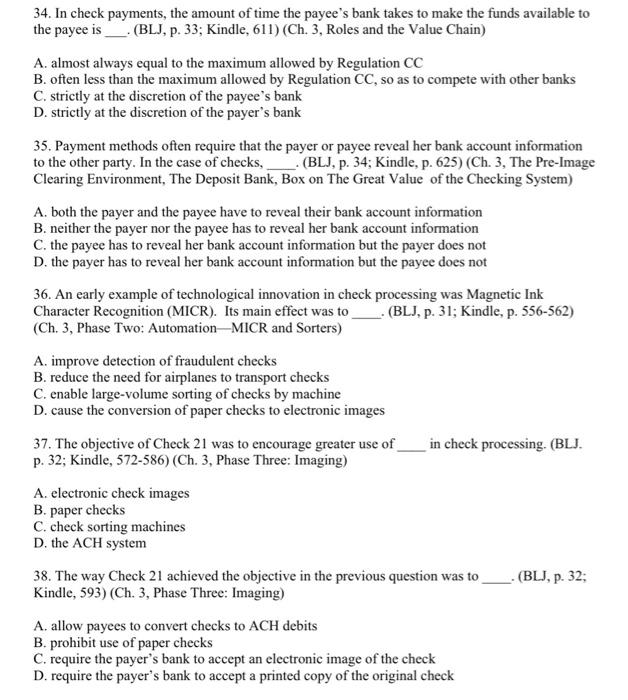34. In check payments, the amount of time the payee's bank takes to make the funds available to the payee is . (BLJ, p. 33; Kindle, 611) (Ch. 3, Roles and the Value Chain) A. almost always equal to the maximum allowed by Regulation CC B. often less than the maximum allowed by Regulation CC, so as to compete with other banks C. strictly at the discretion of the payee's bank D. strictly at the discretion of the payer's bank 35. Payment methods often require that the payer or payee reveal her bank account information to the other party. In the case of checks, __. (BLJ, p. 34; Kindle, p. 625) (Ch. 3, The Pre-Image Clearing Environment, The Deposit Bank, Box on The Great Value of the Checking System) A. both the payer and the payee have to reveal their bank account information B. neither the payer nor the payee has to reveal her bank account information C. the payee has to reveal her bank account information but the payer does not D. the payer has to reveal her bank account information but the payee does not 36. An early example of technological innovation in check processing was Magnetic Ink Character Recognition (MICR). Its main effect was to (Ch. 3, Phase Two: Automation -MICR and Sorters) A. improve detection of fraudulent checks B. reduce the need for airplanes to transport checks C. enable large-volume sorting of checks by machine D. cause the conversion of paper checks to electronic images 37. The objective of Check 21 was to encourage greater use of in check processing. (BLJ. p. 32; Kindle, 572-586) (Ch. 3, Phase Three: Imaging) A. electronic check images B. paper checks C. check sorting machines D. the ACH system 38. The way Check 21 achieved the objective in the previous question was to (BLJ, p. 32; Kindle, 593) (Ch. 3, Phase Three: Imaging) A. allow payees to convert checks to ACH debits B. prohibit use of paper checks C. require the payer's bank to accept an electronic image of the check D. require the payer's bank to accept a printed copy of the original check 34. In check payments, the amount of time the payee's bank takes to make the funds available to the payee is . (BLJ, p. 33; Kindle, 611) (Ch. 3, Roles and the Value Chain) A. almost always equal to the maximum allowed by Regulation CC B. often less than the maximum allowed by Regulation CC, so as to compete with other banks C. strictly at the discretion of the payee's bank D. strictly at the discretion of the payer's bank 35. Payment methods often require that the payer or payee reveal her bank account information to the other party. In the case of checks, __. (BLJ, p. 34; Kindle, p. 625) (Ch. 3, The Pre-Image Clearing Environment, The Deposit Bank, Box on The Great Value of the Checking System) A. both the payer and the payee have to reveal their bank account information B. neither the payer nor the payee has to reveal her bank account information C. the payee has to reveal her bank account information but the payer does not D. the payer has to reveal her bank account information but the payee does not 36. An early example of technological innovation in check processing was Magnetic Ink Character Recognition (MICR). Its main effect was to (Ch. 3, Phase Two: Automation -MICR and Sorters) A. improve detection of fraudulent checks B. reduce the need for airplanes to transport checks C. enable large-volume sorting of checks by machine D. cause the conversion of paper checks to electronic images 37. The objective of Check 21 was to encourage greater use of in check processing. (BLJ. p. 32; Kindle, 572-586) (Ch. 3, Phase Three: Imaging) A. electronic check images B. paper checks C. check sorting machines D. the ACH system 38. The way Check 21 achieved the objective in the previous question was to (BLJ, p. 32; Kindle, 593) (Ch. 3, Phase Three: Imaging) A. allow payees to convert checks to ACH debits B. prohibit use of paper checks C. require the payer's bank to accept an electronic image of the check D. require the payer's bank to accept a printed copy of the original check







